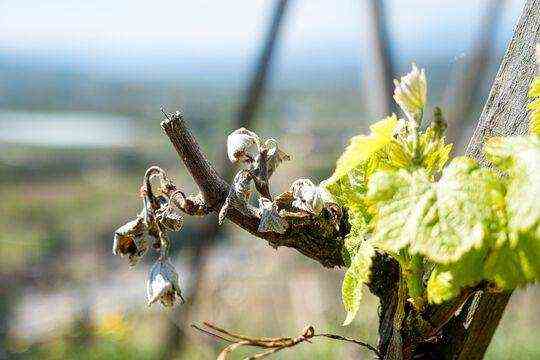Extreme frost wave, early spring … How wine growers will have to adapt to face the vagaries of the weather. – Konrad / Sipa
- The recent frost episode severely damaged a large part of the vineyards.
- More than frost, winegrowers fear seeing ever earlier springs and are wondering how they will have to adapt to the consequences of climate change.
- While some plead for a renewal of the grape varieties, others warn that the task is akin to a real “puzzle”.
The frost episode, which strongly shook the French vineyards, is “historic”. Wine growers recognize this. Rare are those who had already experienced an episode of such intensity at this time of the year, “even if the frosts of April are frequent”. “Temperatures have fallen very low over the whole of the territory (-5 ° C on average) and the question today is to know what will be the capacity of the buds to resist”, asks Philippe Pellaton, president of Inter Rhône for which the problem is not so much the arrival of this cold wave as “the precocity of spring”.
“This year we had a relatively mild winter. Vegetation in the vines started a fortnight in advance. We were on the first buds when the frost hit. If they had hatched two weeks later, we would have passed the cold period without any problem, ”he emphasizes.
Spring too early
Pierre Combat, president of the Crozes-Hermitage appellation, shares the same observation. “It is not normal to have such developed vegetation of our grape varieties at this time of year. The vines are too early. We’ve seen it for three or four years. This is unfortunately a direct consequence of climate change, ”points out the winegrower.
“The early springs are no longer exceptional, they will repeat themselves to be sustainable, warns Christophe David, deputy director of Isara, engineering school in agronomy, agrifood and environment in Lyon. We will have more and more episodes of water stress (lack of water), extreme climatic phenomena (strong frost, heavy precipitation or large hail). Wine growers will no longer be able to work as before. They will have to change their practices ”.
But how to adapt? This is the thorny question facing winegrowers today. Should we plant new varieties? Prune the vines later to avoid bud break too early? “We ask ourselves all these questions but it’s a real puzzle. For the moment, no one has yet a solution or a magic wand, ”Pierre Combat replied bluntly.
Should we review cultivars?
“We can consider using systems such as agrivoltaism that will protect plants from climatic hazards,” suggests Christophe David. There is a real field of research to explore, but it will certainly be necessary to review the cultivar itself by returning to older, more resistant varieties. Some winegrowers, established in the south-east of France, are already doing it and they are doing very well ”.
Pierre Combat remains cautious, however, because the task will not be so easy, he emphasizes from the outset. “We are working on a heritage, living plants. Our best vintages come from old vines. Some have feet that are 50 years old or even 100 years old. They’re not going to pull off the best they’ve got, he argues. Even so, it will be a long-term job which will require, moreover, to modify the specifications of our appellations ”.
Transform the grape varieties? “A matter of two generations”
“In everyone’s imagination, a very good quality wine can only be produced from old vines. No ”, assures Christophe David, who refers to other countries marketing wines whose quality competes or even exceeds that of French vintages. “They manage to have excellent wines with vines that are only six or seven years old and using new grape varieties. Today in France, we mainly have three grape varieties because we have greatly simplified our agricultural model. However, the solution lies in the use of a more diversified agriculture, he believes. Those who do will be the ones who get through it ”.
But here again Pierre Combat has reservations. “Some people believe that this is the solution. However, pulling up and replanting 1,800 hectares of vines to transform them into another grape variety cannot be done quickly or even in ten years. It’s a matter of two generations, ”he replies. And to conclude: “The vine does not replant as easily as the wheat or the vegetables which one finds in annual culture. »A real puzzle.

